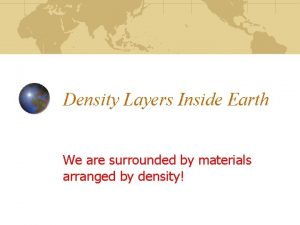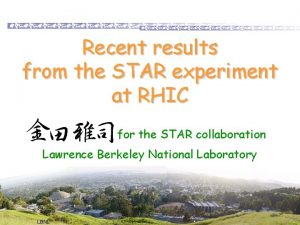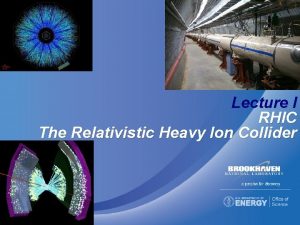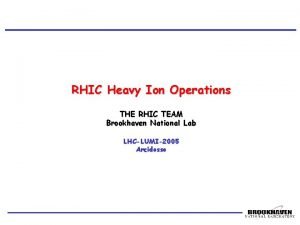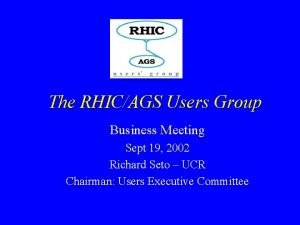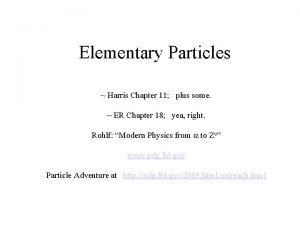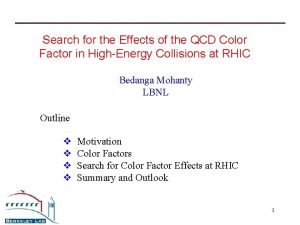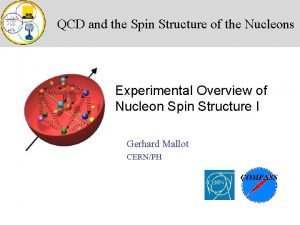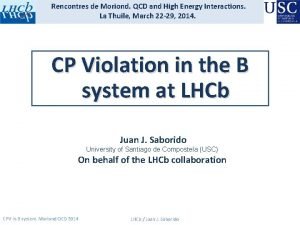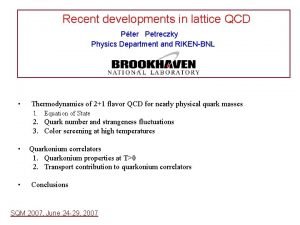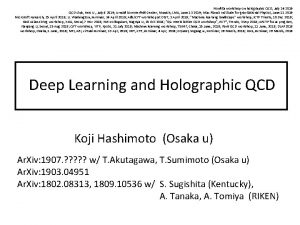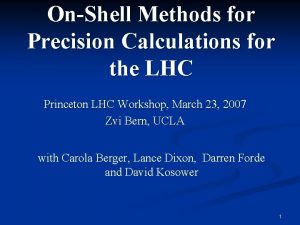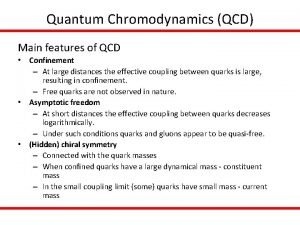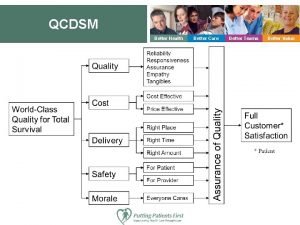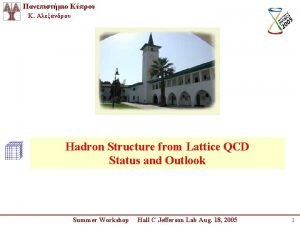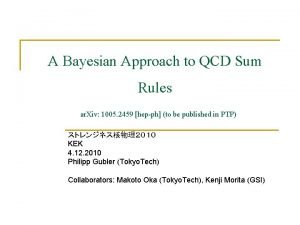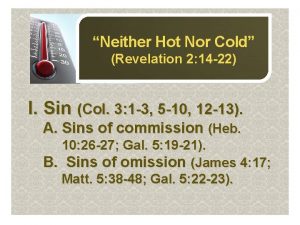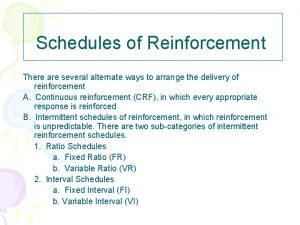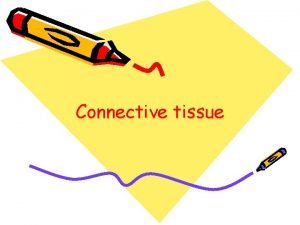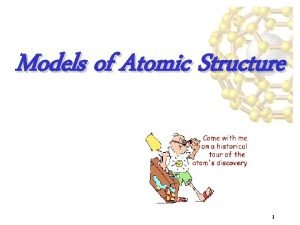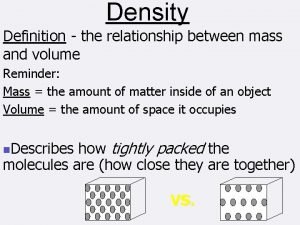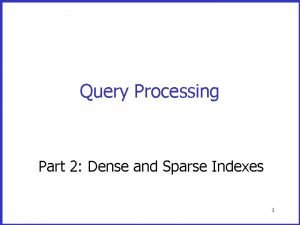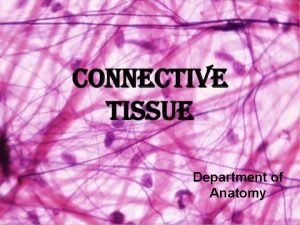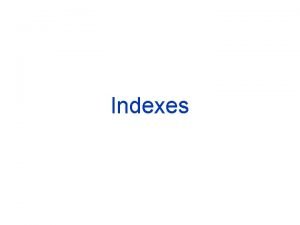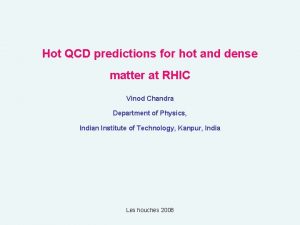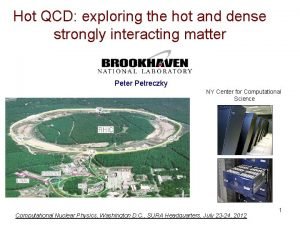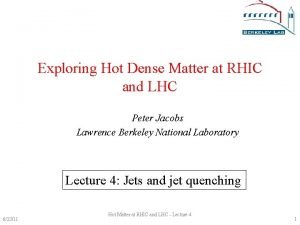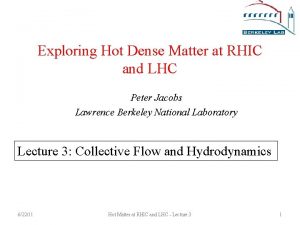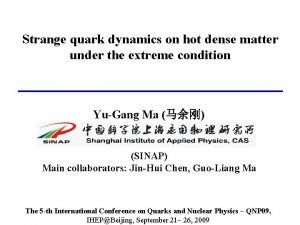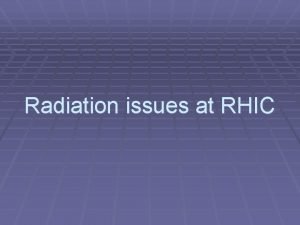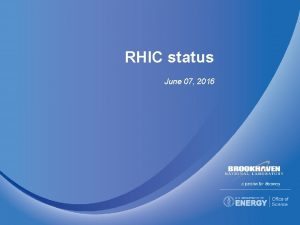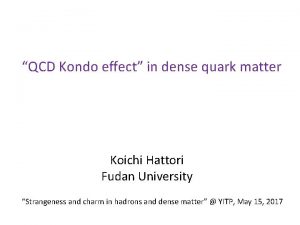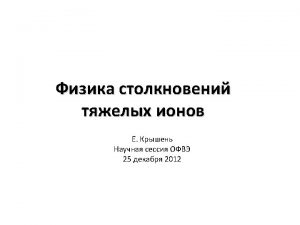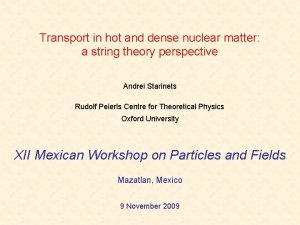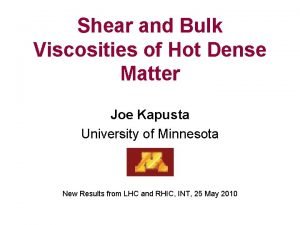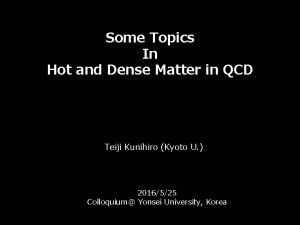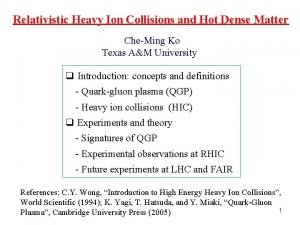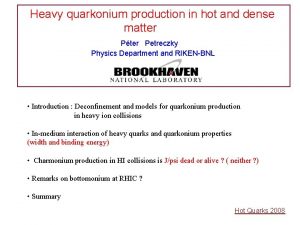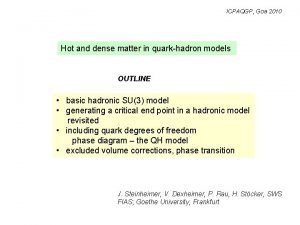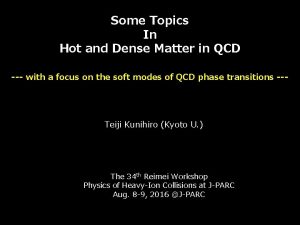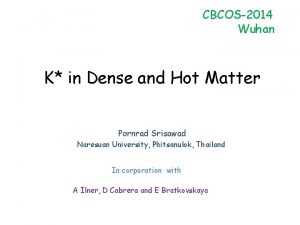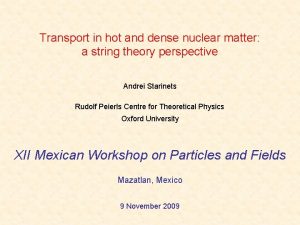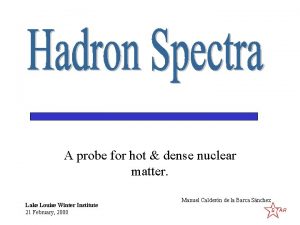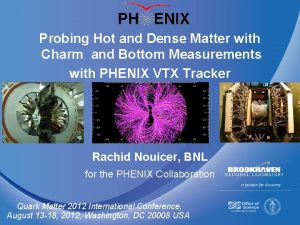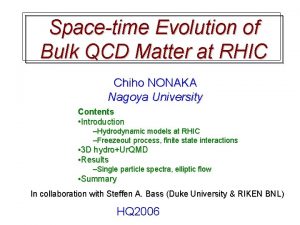Dynamics of hot dense QCD matter from RHIC








































- Slides: 40

Dynamics of hot & dense QCD matter: from RHIC to LHC Steffen A. Bass Duke University • RHIC: the emerging picture • Modeling of Relativistic Heavy-Ion Collisions • Relativistic Fluid Dynamics • Hybrid Macro+Micro Transport • Model Validation: RHIC • Predictions for LHC • Spectra & Yields • Collective Flow • Transport Coefficients: Low Viscosity Matter at LHC? Steffen A. Bass collaborators: • J. Ruppert • T. Renk • C. Nonaka • B. Mueller • A. Majumder • M. Asakawa 1

RHIC: the emerging picture Steffen A. Bass 2

Exploring QCD Matter at RHIC and LHC hadronic phase and freeze-out QGP and hydrodynamic expansion initial state pre-equilibrium hadronization Lattice-Gauge Theory: • rigorous calculation of QCD quantities • works in the infinite size / equilibrium limit Experiments: • observe the final state + penetrating probes • rely on QGP signatures predicted by Theory Phenomenology & Transport Theory: • connect QGP state to observables • provide link between LGT and data Steffen A. Bass 3

Current Picture of QGP Structure: - Lessons from RHIC Jet-Qenching & Elliptic Flow: • QGP produced at RHIC has very large opacity • behaves like an ideal fluid (vanishing viscosity) Lattice Gauge Theory & Parton Recombination: • at TC, QGP degrees of freedom carry the quantum numbers of quarks and recombine to form hadrons Applicability of Ideal Fluid Dynamics and Statistical Model: • matter produced is thermalized • thermalization (isotropization) occurs very early, ~0. 6 fm/c Steffen A. Bass 4

Modeling of Relativistic Heavy-Ion Collisions Steffen A. Bass 5

Survey of Transport Approaches Steffen A. Bass 6

Relativistic Fluid Dynamics Steffen A. Bass 7

Relativistic Fluid Dynamics • transport of macroscopic degrees of freedom • based on conservation laws: μTμν=0 μjμ=0 • for ideal fluid: Tμν= (ε+p) uμ uν - p gμν and jiμ = ρi uμ • Equation of State needed to close system of PDE’s: p=p(T, ρi) Ø connection to Lattice QCD calculation of Eo. S • initial conditions (i. e. thermalized QGP) required for calculation • assumes local thermal equilibrium, vanishing mean free path Ø applicability of hydro is a strong signature for a thermalized system Steffen A. Bass 8

3 D-Hydro: Validation at RHIC separate chemical f. o. simulated by rescaling p, K • 1 st attempt to address all data w/ 1 calculation Nonaka & Bass: PRC 75, 014902 (2007) See also Hirano; Kodama et al. b=6. 3 fm Steffen A. Bass 9

Ideal RFD: Challenges • centrality systematics of v 2 less than perfect • no flavor dependence of cross-sections • separation chemical and kinetic freeze-out: • normalize spectra by hand • PCE: proper normalization, wrong v 2 Nu Xu Viscosity: Csernai QGP: Arnold, Moore & Yaffe HG: Prakash et al. Steffen A. Bass • success of ideal RFD argues for a low viscosity in QGP phase Ø compatible with Ad. S/CFT bound of 1/4π • viscosity will stongly change as function of temperature during collision Ø need to account for viscous corrections in hadronic phase 10

Hybrid Hydro+Micro Approaches Steffen A. Bass 11

3 D-Hydro + Ur. QMD Model Full 3 -d Hydrodynamics QGP evolution Hadronization Cooper-Frye formula Ur. QMD hadronic rescattering Monte Carlo TC TSW t fm/c + micro. transport (Ur. QMD) Hydrodynamics • • • ideally suited for dense systems – model early QGP reaction stage well defined Equation of State parameters: – initial conditions – Equation of State Bass & Dumitru, PRC 61, 064909(2000) Teaney et al, nucl-th/0110037 Nonaka & Bass, PRC 75, 014902 (2007) Hirano et al. nucl-th/0511046 Steffen A. Bass • no equilibrium assumptions Ø model break-up stage Ø calculate freeze-out Ø includes viscosity in hadronic phase • parameters: – (total/partial) cross sections matching condition: • use same set of hadronic states for Eo. S as in Ur. QMD • generate hadrons in each cell using local T and μB 12

3 D-Hydro+Ur. QMD: Validation Ø good description of cross section dependent features & nonequilibrium features of hadronic phase Ø hydrodynamic evolution used for calculation of hard probes Steffen A. Bass 13

Predictions for LHC Steffen A. Bass 14

Initial Conditions @ LHC Ørequired for all hydro-based calculations • can be obtained from: § ab-inito calculations of initial state § analysis of LHC data § phenomenological extrapolation of RHIC data PHOBOS extrapolation: • extend longitudinal scaling • self-similar trapezoidal shape U. Wiedemann QM 06 Saturation model scaling: • ASW: d. Nch/d =1650 • KLN: d. Nch/d =1800 -2100 • EHNRR: d. Nch/d =2570 Steffen A. Bass 15

3 D-Hydro+Ur. QMD: Initial Conditions • Initial Conditions: – energy density longitudinal profile transverse plane – baryon number density – parameters: 0, max , n. Bmax, 0, – flow profile: v. L= Bjorken’s solution); v. T=0 • Equation of State – 1 st order phase transition – Tc=160 Me. V • switching temperature – TSW=150 Me. V RHIC LHC-Bj LHC-1 LHC-2 0(fm) 0. 6 0. 3 0. 2 0 (Ge. V/fm 3) 55 230 1000 500 0 0. 5 N/A 1. 0 1. 4 N/A 6. 0 • note that LHC-Bj initial conditions were not meant to provide a reasonable guess for LHC but rather elucidate a scenario more extreme than RHIC Steffen A. Bass 16

Spectra & Yields Disclaimer: • do not take the following “predictions” too seriously • they only represent placeholders to demonstrate the capabilities of this particular transport approach • once data are available, the parameters of the initial condition will be adjusted in order to establish whether 3 D-Hydro+Ur. QMD can provide a viable description of QGP dynamics at LHC Steffen A. Bass 17

Blast from the Past: Bj-Hydro+Ur. QMD SAB & A. Dumitru: Phys. Rev. C 61 064909 (2000): • boost-invariant 1+1 D RFD with Ur. QMD as hadronic afterburner • RFD validated with SPS data [Dumitru & Rischke: PRC 59 354 (1999)] Ødynamic transition from QGP & mixed phase to hadronic phase • increase in <pt> as function of hadron mass less than linear due to flavordependence of hadronic rescattering Steffen A. Bass 18

From SPS to LHC • from RHIC to LHC: lifetime of QGP phase nearly doubles • only 33% increase in collision numbers of hadronic phase Steffen A. Bass 19

3 D-Hydro+Ur. QMD: Multiplicities d. N/dy LHC-1 LHC-2 at y. CM Steffen A. Bass + 1715 904 K+ 228 123 p 57 34 0+ 0 33 19 + 4. 3 2. 5 - 0. 85 0. 52 20

3 D-Hydro+Ur. QMD: Spectra Steffen A. Bass 21

3 D-Hydro+Ur. QMD: dissipative effects • hadronic phase “cools” pion spectrum • built-up of radial flow for heavier particles Ø pion wind • significant dissipative effects Ø early chemical freeze-out manifest in proton distribution (pure Hydro would need PCE) Steffen A. Bass 22

Hybrid RFD+Boltzmann Summary • validated at RHIC for soft sector and jet energy-loss • treatment of viscosity in hadronic phase • separation of thermal & chemical freeze-out Ø allows for consistent treatment of bulk matter dynamics and hard probes Steffen A. Bass 23

Collective Flow Steffen A. Bass 24

Collision Geometry: Elliptic Flow Reaction plane z Ø The applicability of fluid-dynamics suggests that the medium is in local thermal equilibrium! Ø Note that fluid-dynamics cannot make any statements how the medium reached the equilibrium stage… y x elliptic flow (v 2): • gradients of almond-shape surface will lead to preferential emission in the reaction plane • asymmetry out- vs. in-plane emission is quantified by 2 nd Fourier coefficient of angular distribution: v 2 Ø calculable with fluid-dynamics Steffen A. Bass 25

Elliptic flow: early creation P. Kolb, J. Sollfrank and U. Heinz, PRC 62 (2000) 054909 time evolution of the energy density: initial energy density distribution: spatial eccentricity momentum anisotropy Most hydro calculations suggest that flow anisotropies are generated at the earliest stages of the expansion, on a timescale of ~ 5 fm/c if a QGP Eo. S is assumed. Steffen A. Bass 26

3 D-Hydro (+Ur. QMD): Elliptic Flow • no significant sensitivity to the two initial conditions ( note Kolb, Sollfrank & Heinz: PLB 459 (1999) 667: only small rise) • dissipative effects in hadronic phase do not affect built-up of elliptic flow Ø robust early time signal Steffen A. Bass 27

Transport Coefficients: Low Viscosity Matter M. Asakawa, S. A. Bass & B. Mueller: Phys. Rev. Lett. 96 (2006) 252301 Prog. Theo. Phys. 116 (2006) 725 Steffen A. Bass 28

Viscosity: from RHIC to LHC initial state hadronic phase and freeze-out QGP and hydrodynamic expansion pre-equilibrium hadronization large elliptic flow & success of ideal RFD: zero/small viscosity expanding hadron gas w/ significant & increasing mean free path: large viscosity • viscosity of matter changes strongly with time & phase • Hydro+Ur. QMD: viscous corrections for hadron gas phase • how to understand low viscosity in QGP phase? • will low viscosity features persist at LHC? Steffen A. Bass 29

The s. QGP Dilemma Ø the success of ideal hydrodynamics has led the community to equate low viscosity with a vanishing mean free path and thus large parton cross sections: strongly interacting QGP (s. QGP) • microscopic transport theory shows that assuming quasi-particle q & g degrees of freedom would require unphysically large parton cross sections to match elliptic flow data • even for λ 0. 1 fm (close to uncertainty bound) dissipative effects are large D. Molnar Ø does a small viscosity have to imply that matter is strongly interacting? Ø consider effects of (turbulent) color fields Steffen A. Bass 30

Anomalous Viscosity: Ø any contribution to the shear viscosity not explicitly resulting from momentum transport via a transport cross section • Plasma physics: – A. V. = large viscosity induced in nearly collisionless plasmas by long-range fields generated by plasma instabilities. • Astrophysics - dynamics of accretion disks: – A. V. = large viscosity induced in weakly magnetized, ionized stellar accretion disks by orbital instabilities. • Biophysics: – A. V. = The viscous behavior of nonhomogenous fluids, e. g. , blood, in which the apparent viscosity increases as flow or shear rate decreases toward zero. • Can the QGP viscosity be anomalous? – Expanding plasmas (e. g. QGP @ RHIC) have anisotropic momentum distributions – plasma turbulence arises naturally in plasmas with an anisotropic momentum distribution (Weibel-type instabilities). Ø soft color fields generate anomalous transport coefficients, which may give the medium the character of a nearly perfect fluid even at moderately weak coupling. Steffen A. Bass 31

Weibel (two-stream) instability Ultra-Relativistic Heavy-Ion Collision: two streams of colliding color charges • consider the effect of a seed magnetic field with • pos. charges deflect as shown: alternately focus and defocus • neg. charges defocus where pos. focus and vice versa Ø net-current induced, grows with time • induced current creates B, adds to seed B • opposing currents repel each other: filamentation Ø exponential Weibel instability Guy Moore, Mc. Gill Univ. Steffen A. Bass 32

Hard Thermal Loops: Instabilities Nonabelian Vlasov equations describe interaction of “hard” (i. e. particle) and “soft” color field modes and generate the “hard-thermal loop” effective theory: Effective HTL theory permits systematic study of instabilities of “soft” color fields: find HTL modes for anisotropic distribution: Ø for any ξ 0 there exist unstable modes Ø energy-density and growth rate of unstable modes can be calculated: Romatschke & Strickland, PRD 68: 036004 (2003) Arnold, Lenaghan & Moore, JHEP 0308, 002 (2003) Mrowczynski, PLB 314, 118 (1993) Steffen A. Bass 33

Anomalous Viscosity Derivation: Sketch • linear Response: connect η with momentum anisotropy Δ: • use color Vlasov-Boltzmann Eqn. to solve for f and Δ: • Turbulent color field assumption: • ensemble average over fields: Ø diffusive Vlasov-Boltzmann Eqn: • example: anomalous viscosity in case of transverse magnetic fields • complete calculation of η via variational principle: Steffen A. Bass 34

Collisional vs. Anomalous Viscosity collisional viscosity: • derived in HTL weak coupling limit anomalous viscosity: • induced by turbulent color fields, due to momentum-space anisotropy • with ansatz for fields: Ø for reasonable values of g: A < C Steffen A. Bass M. Asakawa, S. A. Bass & B. Mueller: Phys. Rev. Lett. 96 (2006) 252301 Prog. Theo. Phys. 116 (2006) 725 35

Time-Evolution of Viscosity hadronic phase and freeze-out QGP and hydrodynamic expansion initial state pre-equilibrium viscosity: • relaxation rates are additive Ø sumrule for viscosities: hadronization ? ? Ø smaller viscosity dominates in system w/ 2 viscosities! temperature evolution: Steffen A. Bass 36

Viscosity at LHC: Two Scenarios field picture: • (turbulent) color fields induce an anomalous viscosity, which keeps the total shear-viscosity small during the QGP evolution Ø perfect liquidity in the weak coupling limit collisional picture: • weaker coupling at LHC vs. RHIC will lead to a larger viscosity Ø increase in dissipative effects, deviations from ideal fluid Ø elliptic flow at LHC compared to RHIC can act as a decisive measurement for the dominance of anomalous viscosity Steffen A. Bass 37

Summary and Outlook • Heavy-Ion collisions at RHIC have produced a state of matter which behaves similar to an ideal fluid Ø Hydro+Micro transport approaches are the best tool to describe the soft, non-perturbative physics at RHIC after QGP formation Ø at LHC, such hybrid models should perform well if QGP matter is found to have a low viscosity • a small viscosity does not necessarily imply strongly interacting matter! Ø (turbulent) color fields induce an anomalous viscosity, which keeps the total sheer-viscosity small during the QGP evolution Ø elliptic flow at LHC as decisive measurement on impact of anomalous viscosity Note: • due to it’s slow & nearly isotropic expansion, the early Universe most likely did not have an anomalous contribution to its viscosity Steffen A. Bass 38

The End Steffen A. Bass 39

Elliptic Flow: ultra-cold Fermi-Gas • Li-atoms released from an optical trap exhibit elliptic flow analogous to what is observed in ultrarelativistic heavy-ion collisions Ø Elliptic flow is a general feature of strongly interacting systems! Steffen A. Bass 40
 Earth's layers most dense to least dense
Earth's layers most dense to least dense Crust outer core inner core mantle
Crust outer core inner core mantle The layers of earth from most dense to least dense
The layers of earth from most dense to least dense Rhic
Rhic Rhic
Rhic Rhic brookhaven
Rhic brookhaven Rhic ags users meeting 2020
Rhic ags users meeting 2020 Qcd lagrangian
Qcd lagrangian Electroweak interaction
Electroweak interaction Color factor qcd
Color factor qcd Nucleon
Nucleon Rencontres de moriond
Rencontres de moriond Qcd
Qcd Qcd
Qcd Qcd penrose
Qcd penrose Qcd confinement
Qcd confinement Qcsdm
Qcsdm Qcd
Qcd Qcd sum rules
Qcd sum rules Perbedaan hot lava dan hot lava volcano
Perbedaan hot lava dan hot lava volcano Hot nor
Hot nor White hot vs red hot temperature
White hot vs red hot temperature Advantages of cold working
Advantages of cold working Gray matter vs white matter
Gray matter vs white matter Classification of matter section 1 composition of matter
Classification of matter section 1 composition of matter Flow energy review
Flow energy review Section 1 composition of matter
Section 1 composition of matter Gray matter and white matter
Gray matter and white matter Chapter 2 matter section 1 classifying matter answer key
Chapter 2 matter section 1 classifying matter answer key Section 1 composition of matter
Section 1 composition of matter Telecephalon
Telecephalon Gyrus and sulcus function
Gyrus and sulcus function Reinforcement schedules
Reinforcement schedules Dense connective tissue definition
Dense connective tissue definition Cathode ray tube
Cathode ray tube Mass and volume definition
Mass and volume definition Molecular cell biology lecture
Molecular cell biology lecture Wards triangle
Wards triangle Dense index vs sparse index
Dense index vs sparse index Tissue type
Tissue type Define dense index
Define dense index
